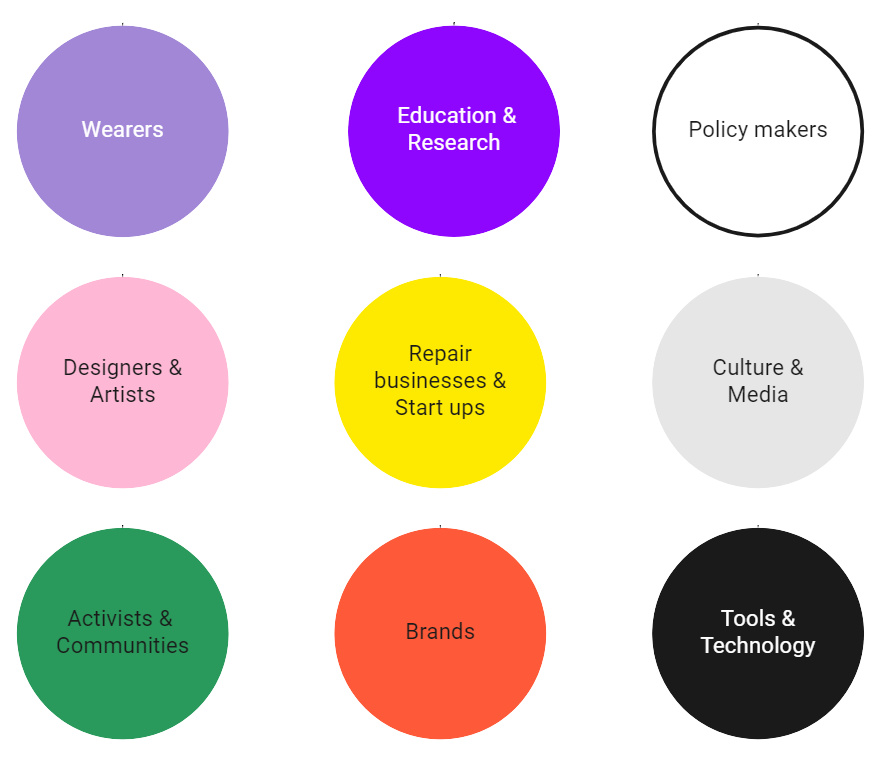This map provides an overview of possibilities and works as a resource for (re)imagining the fashion system. With colorful dots and short titles, it sketches preferable and wholistic futures governed by an overarching regenerative ethos, where we try to actively undo the damage done to the planet and living beings by centuries of (corporate) colonialism and to reconsider our relationship with clothes and care.
The map of repair futures
This landscape, that we and many other people long to see, is characterised by an equal balance of power between the so-called Global North and Global South, as well as strong protective policies, corporate accountability, activism and the integration of repair and care objectives into all levels of education.
For whom
It is meant for designers, start-ups, repair businesses, brands, educators, activists, policymakers, and anyone interested in repair and its potential to transform our relationships with clothes, material objects and the world.
Made with
It is co-created with a large community of people, many of whom are involved in different forms of repair and is shaped through public mapping sessions, online questionnaires, research, and open online contributions. Although presented in anonymous form it often refers to ideas and solutions proposed by prominent researchers and activists. Where possible we link these ideas to texts and webs-sites, but in cases where the references are many or none, we only mention the idea itself.
How to read it:
Actors
There are different actors who are important for building the cultures and infrastructures of repair, and while the role of some, such as repair businesses and activists seems apparent, the impact of others, such as brands and schools, while being profound might look so obvious.
We have focused on the following actors, even though their definitions here are quite flexible. You can see the ideas and solutions connected to them represented by circles of different colours.

Combination of circles shows that an idea might be relevant for several actors. For example, upcycling services can be a great solution for designers, brands, repair businesses and other players.
Sizes
The circles can be larger or smaller, with the size showing the current or potential impact of a solution for building regenerative culture and economy. Of course, this impact is only estimated by us and does not reflect the actual significance of a certain idea.
But we try to represent some fundamental conditions, for example the downsizing and decentralization of the fashion industry, or the common understanding of the value of materials and (care) work, with large forms.
Present and Futures
We show possibilities that are available now, highlight new ideas and approaches as seeds of change, and sketch opportunities that can be open in the future.

Sometimes we place an existing solution in a larger semi-transparent circle to indicate its potential growth and possible impact, as we do with the repair and alteration services structurally offered by brands.
Spatial relations
The map traces a largely circular process, although represented in linear graphics. It follows the lifecycle of a garment and starts at the top with the general context, design and production, continues down to use, repair and reuse, and loops back into new production, with a negligible amount of waste.
We have tried to group together related and intersecting ideas, as well as to map several thematic zones, such as justice-led and regenerative economy or the efforts of people fixing things together.
Because a number of featured ideas is connected with multiple others, it was not always possible to place them all next to each other. For example, local fashion production and shorter supply chains, although directly connected to each other, also gravitate to distinct themes, such as multiple fashion centers and sustainability as the norm. This is why we sometimes place related ideas to different parts of the map.
We are conscious that a mind map format might be more difficult to read that an excel list, but we hope that it will provide a good overview of the landscape and will visually demponstrate the situation of deep interconnectedness of the different factors that are necessary for building stable cultures and infrastructures of repair. We also hope that exploring these constellations you might come across new ideas that can support and inspire your practice.
This is an open solution map, which welcomes new thoughts and references. If you would like to add more of them here and give others a tip, please submit your ideas via this form. After some time, you will see them added to the map.